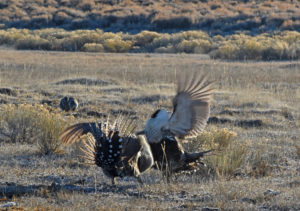For Immediate release
July 14, 2020
Contact:
Erik Molvar, Western Watersheds Project, (307) 399-7910, emolvar@westernwatersheds.org
LARAMIE, Wyo. – Western Watersheds Project today filed a formal legal objection to the U.S. Forest Service’s Thunder Basin National Grassland Plan Amendment because the new plan expands prairie dog poisoning, removes black-footed ferret reintroduction as a central management goal of the Grassland, and opens up nearly 50,000 previously-protected acres for the recreational shooting of prairie dogs which are the critical (indeed, virtually the sole) source of food and habitat for the endangered black-footed ferret.
“It’s pretty obvious that a handful of anti-conservation ranchers have hijacked the management of a vast swath of public lands in Wyoming, and they seek to exterminate native wildlife so their cattle can have more grass,” said Molvar. “The Thunder Basin is a National Grassland that is supposed to be managed to promote healthy lands and benefit all Americans, not just a privileged and entitled few who profit off the land.”
The new plan amendment came at the insistence of ranchers in northeast Wyoming, who convinced former Governor Mead to pressure the Forest Service to remove protections for prairie dogs in an officially designated Black-Footed Ferret Recovery Area, and to replace ferret recovery emphasis with a focus on livestock and “short-stature vegetation” in the new plan.
“There are cattle everywhere on the Great Plains but there are very few big tracts of public land with the potential to sustain populations of black-footed ferrets,” said Molvar. “It was the ranchers who poisoned off all the prairie dogs and drove the black-footed ferret to the brink of extinction in the first place. If there is a conflict between ferret recovery and livestock on public land, it is ranching that needs to be changed.”
Western Watersheds Projects’ objection points out that the Forest Service has a legal obligation to recover endangered species like the black-footed ferret, and to maintain viable populations of wildlife. Black-footed ferrets rely on prairie dogs for more than 90 percent of their diets, but the new plan amendment sets the acreage of prairie dog colonies to a level substantially lower than the population threshold that black-footed ferrets need to thrive according to science. The black-tailed prairie dog – targeted for expanded poisoning and shooting under the plan amendment – is designated as a Sensitive Species by the Forest Service, and is supposed to be considered a high priority for conservation. Other imperiled wildlife species, like mountain plovers, burrowing owls, ferruginous hawks, swift foxes, and golden eagles, are also heavily dependent on large colonies of prairie dogs for their survival.
“The prairie dogs is a keystone species for grassland ecosystems, providing essential habitat for a number of rare grassland wildlife species, from burrowing owls to mountain plovers,” said Molvar. “The Forest shouldn’t be in the business of poisoning off its own Sensitive Species. The idea of setting up a killing field along Grassland boundaries to prevent the natural movements of native wildlife to and from public lands is illegal and deeply disturbing.”
###






